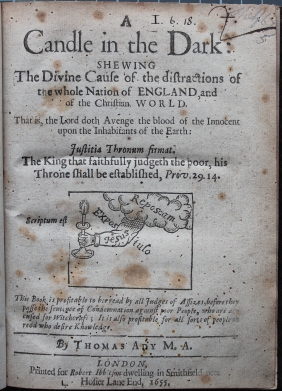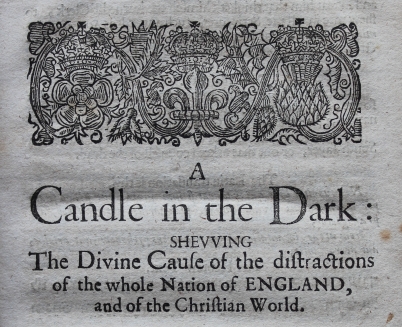 Given that today many are celebrating Halloween it seems fitting to showcase a rare seventeenth-century book we’ve recently discovered in the Thackeray Collection on the subject of witchcraft. The book is the first edition of A Candle in the Dark, shewing the Divine Cause of the distractions of the whole Nation of England and of the Christian world written by Thomas Ady, of which only a handful of copies are extant. A Cambridge graduate, Ady was a physician, humanist and author of three books about witchcraft. He was a critical exposer of both persecutions for alleged witchcraft and practices such as fortune-telling which often led to witchcraft trials during the seventeenth century. It is estimated that 40,000-60,000 people were condemned to death as witches in Europe during the late-sixteenth and seventeenth centuries.
Given that today many are celebrating Halloween it seems fitting to showcase a rare seventeenth-century book we’ve recently discovered in the Thackeray Collection on the subject of witchcraft. The book is the first edition of A Candle in the Dark, shewing the Divine Cause of the distractions of the whole Nation of England and of the Christian world written by Thomas Ady, of which only a handful of copies are extant. A Cambridge graduate, Ady was a physician, humanist and author of three books about witchcraft. He was a critical exposer of both persecutions for alleged witchcraft and practices such as fortune-telling which often led to witchcraft trials during the seventeenth century. It is estimated that 40,000-60,000 people were condemned to death as witches in Europe during the late-sixteenth and seventeenth centuries.
Published in London in 1655, A Candle in the Dark makes clear its intended audience through the following description on its title page: ‘this book is profitable to be read by all judges of assizes, before they passe the sentence of condemnation against poor people, who are accused for witchcraft; it is also profitable for all sorts of people to read who desire knowledge’. Like his opponents, Ady supported his arguments through reference to scripture in order to prove that it was both impossible for witches to exist and that it was indeed unchristian to accuse someone of witchcraft.
Ady’s volume begins with a section entitled ‘The Reason of the Book’ in which he laments: ‘the grand errour of these latter ages is ascribing power to witches, and by foolish imagination of mens brains, without grounds in the scriptures, wrongfull killing of the innocent under the name of witches; unto which idolatry and bloud-guiltiness (being as bad, or worse than the idolatry of the ancient Heathen) men are led as violently by fond imagination, as were the Ephesians to the worshipping of Diana …’ The volume is then divided into three books, the first ‘shewing what witches are in scripture-sense’, the second ‘shewing how grossly the scriptures have been mis-interpreted by antichrist concerning witches’, and the third ‘touching some erroneous English writers, who have upheld the same errors which antichrist hath broached to the world’. The volume includes discussions of divination, astrology, conjuring, the use of charms, oracles, soothsayers and necromancers.

Thomas Ady, A Candle in the Dark (London, 1655). Ady discusses the various means of examination and torture in order to make people confess to witchcraft.
One particularly interesting facet of this book is that it contains one of the earliest known references to the phrase hocus pocus, a term used by magicians nowadays in much the same way as abracadabra, but when it was first coined conjurors perhaps could have expected such phrases to fool the audience into thinking mysterious forces were at work. Ady’s description is as follows:
The first [feature that juggling (i.e. conjuring) consists of] is profitably seen in our common juglers, that go up and down to play their tricks in fayrs and markets, I will speak of one man more excelling in that craft than others, that went about in King James his time, and long since, who called himself, The Kings Majesties most excellent Hocus Pocus, and so was he called, because that at the playing of every trick, he used to say, Hocus pocus, tontus talontus, vade celeriter jubeo, a dark composure of words, to blinde the eyes of the beholders, to make his Trick pass the more currantly without discovery…

Thomas Ady, A Candle in the Dark (1655). Ady discusses the use of the phrase hocus pocus by a seventeenth-century juglar (conjurer).
The arguments presented in this volume travelled far beyond the shores or our small island. One George Burroughs (c.1652-1692), who was originally born in Suffolk before being taken to Massachusetts where he was raised by his mother, was familiar with Ady’s work. An American congregational pastor, Burroughs became minister in Salem Village in 1680, a position he held until 1683 following a dispute with some of his parishioners. Based on the accusation of some personal enemies from his former congregation who had sued him for debt, Burroughs was arrested in April 1692 and accused of witchcraft. At his trial he used A Candle in the Dark in his defence, but, alas, to no avail as he was hanged on 19 August in that year in Salem, and was the only minister to suffer this fate. Shortly before his execution, Burroughs made a speech stating his innocence with such solemnity and to the admiration of so many present that his accusers claimed the devil was standing beside him dictating.
Happy Halloween, everyone!
JC




